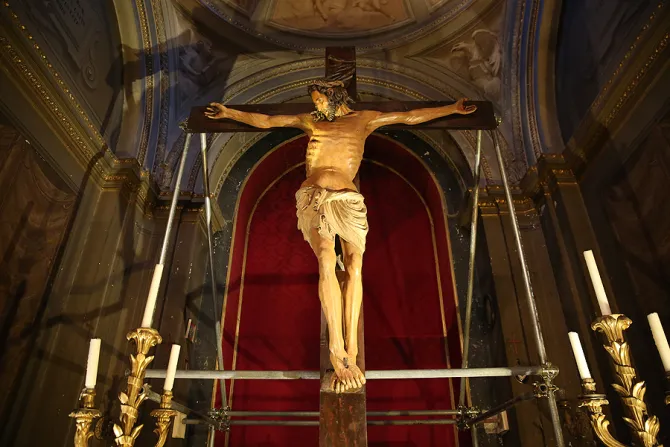Rome, Italy, Jan 11, 2015 / 16:03 pm
After receiving inspiration from an aged crucifix, Cardinal James Stafford commissioned it to be restored as a sign of compassion for Rome's suffering poor and unemployed population.
Cardinal Stafford told CNA Jan. 9 that the cross has been restored "out of a hermeneutics of compassion and to rediscover compassion, to help the poor rediscover the fact that there is a compassionate world (out) there."
The restoration of the crucifix and the opening of the chapel in which it now sits for veneration are also a sign that "the Church can in some ways share that compassion with (the poor) by opening up this chapel in a way that was more accessible," he said.
Originally from Baltimore, Cardinal Stafford is now retired, but previously served as Major Penitentiary of the Apostolic Penitentiary. He is cardinal-priest of San Pietro in Montorio.
Located in Rome since 1997, the cardinal lives in an apartment that sits beside the Basilica of Santa Maria in Trastevere, one of Rome's oldest churches.
He explained that since the church sits so close to his residence, he would often go inside to pray. It is there that he discovered a side chapel that contained a large, aged, worn crucifix dating back to the 1300s.
The crucifix was accompanied in its chapel by an image of Our Lady of Sorrows, which art restorers estimate came from the school of renowned Italian artist Gian Lorenzo Bernini in the 1600s.
"When I first came I went to the chapel and prayed before the crucifix … but as I looked upon it, even in the very dark color that it had assumed through centuries, it did not have the appeal that I felt was obvious beneath the color of black," the cardinal recalled.
It was the body of Christ on the crucifix that first caught the cardinal's attention, which he said was "so expressive in its beauty."
"I was deeply moved when I looked upon it; even in the darkness of the paint that had covered it, there was a beauty to the body that spoke of love that came through giving of himself for others, on behalf of us."
After gazing at the crucifix, Cardinal Stafford recalled how he began to think of the poor people outside the church, and felt an immense desire to draw closer to the image and to show others "this truth, this goodness, and this beauty of Christ that was portrayed in his suffering body."
He then spoke to the priest in charge of the basilica, Don Marco Gnavi, about raising the funds to have the crucifix and the image of Our Lady of Sorrows restored.
Most of the area's poor are not those who live in homes and who suffer due to a lack of food or financial strain, but are rather what the Italians refer to as those "senza tetti," meaning those "without a roof" over their head.
"Young and old, men and women, artisans and unskilled persons, all formerly employed but unemployed now, mentally ill persons who unfortunately are on their own without any great help from the state" are all included among those suffering in the area.
These are the people "whom I perceived as having the need of this crucifix (to be) seen and readily available, accessible to them," Cardinal Stafford explained.
Begun in 2013, the restoration of the crucifix and the image of Our Lady of Sorrows took roughly a year.
Cardinal Stafford pointed out how visits to the small chapel have increased since the artwork was restored, uncovering the eyes, wounds, blood and facial expressions of Christ which were previously masked by the buildup of dust over the centuries.
For the cardinal, the crucifix and its restoration "is really a discovery of the desire to deepen profoundly our sense of compassion, the compassionate God and the compassion that his disciples should show to one another."
Although he does not go the church every day, Cardinal Stafford said that he stops by frequently, and that whenever he does, he pauses to pray in front of the newly restored crucifix and the image of Christ's sorrowful mother.



